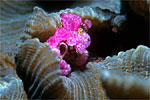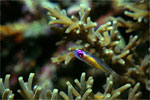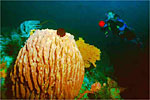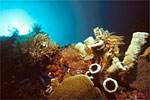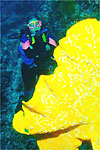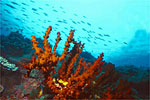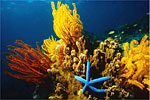


The famous Dakak Beach is most known for its strikingly shaped bay and powdery white sand, and as a diving Mecca in Mindanao. Perfect blue waters, tremendous dive sites with great quantity of coral reefs, and a wonderful sunset scope characterize this tropical Eden. Dakak Park and Beach Resort boasts 15 hectares of wooded land, a natural reservoir for native plants and animals, and a 750-meter private white-sand beach.
Nestled on the tip of Northern Zamboanga, Dakak faces the Sulu Sea in the west and is surrounded by mountains on its east side. Conveniently encircled by large island, Dakak tactfully avoids the typhoon belt, making it the ideal all-season destination
Nestled on the tip of Northern Zamboanga, Dakak faces the Sulu Sea in the west and is surrounded by mountains on its east side. Conveniently encircled by large island, Dakak tactfully avoids the typhoon belt, making it the ideal all-season destination
      |
Zamboanga del Norte today is equally famous for Dakak Beach, the province's leading natural attraction. The very popular Dakak Beach is most known for its beautifully shaped cove and powdery white sand, and as a diving mecca in Mindanao. Perfect blue waters, tremendous dive sites with an wealth of coral reefs, and a splendid sunset horizon distinguish this tropical Eden. Dakak Park and Beach Resort boasts 15 hectares of wooded land, a natural reservoir for native plants and animals, and a 750-meter private white-sand beach
In Dipolog which is about 2 hours by air from Manila, you will enjoy the beauty of Dakak where you can discover coral reefs while you scuba dive in astonishing clear waters. It also boasts of fine white sand and surrounded by glamorous flowers and coconut palms.
Diving sites in Dakak
Diving in Dakak is best in the months of March until September. Dakak dive sites in the beach resort provide a variety of environment from gradual slopes to coral thickets, vertical walls and caves. Marine life is assorted. Some spots are thick with soft coral growth and huge basket sponges, others with schools of jacks, surgeons, and small reef inhabitant. Liuay Rock A low dive, sloping bottom, and a good selection of invertebrates, especially soft corals. Unusual nudibranchs and several species of starfish. Good for novices for general poking around. Ideal for check-out dives. The Caves Striking walls drop to an average of 60 degrees where there is a sandy bottom and a series of caves occupied by sweepers, soldier fish, puffer fish, and sea plumes. Some nice bushes of black coral are seen here. Night diving is impressive with Spanish dancers, sleeping fish and a wide diversity of nocturnal crustaceans. Mushrom Wall At only 10 ft, the shallow roof area turns to a nice wall with fan corals, encrusting sponges, crevices, small ledges and dramatic undercuts, bottoming out at 60 feet. Huge scraps of hard corals (Stag horn, lettuce leaf) with thousands of reef fish separate Mushroom Wall from "The Caves" on its end and to Snapper Ridge to the West. The Gardens A sequence of coral gardens, small walls, sandy area with coral heads and slopes with soft corals. Plenty of anthias, hawk fish, and invertebrates. Good for snorkeling and for trainee or beginner in diving. Cesar's Reef Tiny reef area with bounded coral covers. Rich with large fish such as napoleon wrasses (Chiefly tropical marine fishes with fleshy lips and powerful teeth; usually brightly colored), tuna and parrot fish. View schools of surgeon fish, barracuda (Any voracious marine fish of the genus Sphyraena having an elongated cylindrical body and large mouth with projecting lower jaw and long strong teeth), snappers, and blue-spotted sting rays. For experienced divers only. The Wreck Seven year old sunken passenger liner with bottom depth of 180 feet, and 130 feet at its highest point. Big schools of fish from deck such as black and white snappers, red snapper, jacks, and groupers. Great visibility. For adventurous, experienced divers. Octopus Wall Small wall with pretty growth, octopuses, scorpion fish, sponges, tubastrea, continuous into a slope to the north with some strange crinoids covered formations provide a very scenic view of rudderfish, groupers, etc. Buchok's Reef A series of large coral mounds with nice selection of marine life: giant reef rays, small white tip sharks, unicorn surgeons, snappers and sweetlips. For experienced divers only. Challenger Reef The reef area is almost half the size of Aligua, its top is about 125 feet deep, with soft coral growth. The northern part of the island has short walls and a long narrow opening and a few juvenile fish. Romy's Reef Plenty of coral mounds, with enormous basket sponges, a fine and nice selection of reef fish and invertebrates. Sightings have been reported of blue spotted rays and a few turtles. Some coral damage and unfruitful areas though; eastern area though has massive coral thickets and extends through to Escuelahan. Eskuelahan Named for the numerous schools of fish (snappers, jacks, rainbow runners, surgeons, etc) and occasional tuna found in the area. It is a center of activity with fish of all sizes feeding. Giant frog fish have been also sighted. Currents may be a problem for novice divers. |
